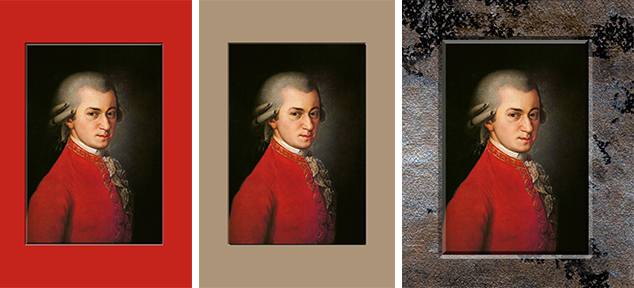
a mat with texture also adds depth to the artwork (Crescent Couture Silver
Birch #1309)
By Tara Crichton Picture framing at its simplest is a craft, and, if you reduce it even further, it is a business. I’m not fond of the business side of framing. The business chores I must perform every couple of months have become the bane of my existence, and I can’t wait until the bottom line of my business allows me the luxury of delegating them to someone else. There is good reason that I didn’t become an accountant.
You would think that, after years of repetition, the possibly monotonous labor of cutting frames, glass, mats and backing would cease to thrill. And, although they don’t make my heart beat faster in avid anticipation, they provide a feeling that is less like a new love and more like a good marriage. There is a more solid, steady feeling of satisfaction with every step that brings me closer to a job’s completion.
My craft demands sterile perfectionism—perfect joins, clean glass and smooth surfaces—and I base my art on that perfectionism. It is like the canvas that a painter uses when realizing a masterpiece. It provides those details that the customer sees and those they don’t, and it thus makes or breaks the artwork.
At the very least, mats should have the smallest possible overcuts, glass should be free of dirt or fingerprints, and frame corners should be tight and touched up so that the seam is virtually invisible. The superior materials and methods that preserve and conserve are also crucial. All my work is for nothing if shoddy workmanship undermines the superficial appearance. For example, paper mats can fade and discolor, cardboard backing acids can denature the art, and masking tape can dry into powder. Some performance art uses materials that rot and decay as a statement; picture framing is not that kind of art.
It takes time and skill to achieve the invisible perfection that showcases the customer’s art and makes no effort to take center stage. The frames, mats and glass are the paints of my art. They are the means of building depth, scale, intensity and volume.
The sum of these skills becomes gloriously greater than the parts. The frame and mat you choose create the art’s focus. The matting and frame width can give the art more visual weight and significance. Dark colors reinforce this effect, attracting light and more vividly contrasting the artwork with its surroundings. The matting color you use reacts with the colors in the art, causing them to either recede or advance. White or creamy mats, on the other hand, are the exceptions to this rule. They provide the best way to create a visually open area around the art that stays neutral as long as you find the right level of white.
Using colors that are the opposite of a main color in the art has an interesting push-pull effect. Such opposites include red and green, yellow and purple, and blue and orange. Use that optical effect with caution, though. It’s a bit like putting a juggling act in your show; make sure the main attraction can hold its own. You can mute the effect by using grayed-down versions of the colors.
There is sometimes no reason why something works or doesn’t work. Listen to what your trained senses tell you. If what you are laying down doesn’t seem like the perfect combination, keep pulling and keep putting options down. Pull some frames that you are sure won’t work. On the other hand, a “wrong” frame can suddenly and mysteriously look incredible, and finding one is among my secret joys.
Inspiration is the main motivator that elevates my craft beyond drudgery. Artists become inspired and fall in love with their subjects. My love affair with texture, which I’ve written about before, is still going strong. Although that type of love doesn’t die easily, I know that I have to love my client’s art more. I can’t put together all my favorite things, regardless of how it works on a watercolor, intaglio print, family photo or golf shirt. It’s difficult to frame all the disparate objects your clients bring to you. You can get caught up in the technical details and lose the spark that makes the entire project shine. This inspiration doesn’t live in a vacuum; it is something you have to work to maintain.
We are so lucky to live in a time during which the internet lets us keep in touch with what is happening around the world. I’m a bit backward in the social-media world. Although I love Pinterest, Instagram and Flickr, Facebook doesn’t interest me at all. I want to know what strangers are doing and what inspires them.
Inspiration is contagious. I get inspired watching fashion shows on vogue.com or documentaries on Netflix. I also love flipping through home-decor magazines while waiting in line at the grocery store. Trade shows are an invaluable opportunity for framers to pick the brains of other industry professionals. You don’t have to steal their ideas; they will give them to you. The well-thought-out displays of framed art with new mouldings and products are bound to get your artistic juices flowing.
For me, picture framing is everything that bookkeeping is not. It is passion and craft, paint and sculpture, creativity and practical application—all wrapped up together. There is an art to great picture framing that is fulfilling and rewarding to produce, and the rewards come from customer loyalty. There is magic in becoming inspired by art and creating the best possible artistic method of framing to preserve and enhance it. Tara Crighton has worked in the framing industry for more than 24 years and is a graduate of University of Guelph with a double major in fine arts. She has worked in every aspect of the framing industry including retail, wholesale distribution, OEM and art direction. She now owns and operates a gallery just north of Toronto.



